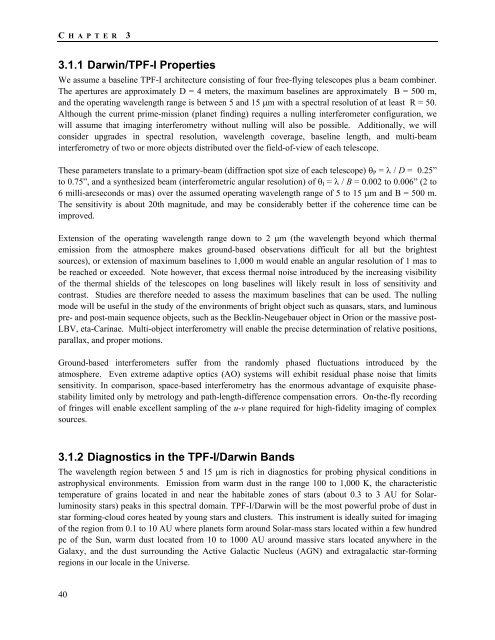TPF-I SWG Report - Exoplanet Exploration Program - NASA
TPF-I SWG Report - Exoplanet Exploration Program - NASA
TPF-I SWG Report - Exoplanet Exploration Program - NASA
You also want an ePaper? Increase the reach of your titles
YUMPU automatically turns print PDFs into web optimized ePapers that Google loves.
C HAPTER 3<br />
3.1.1 Darwin/<strong>TPF</strong>-I Properties<br />
We assume a baseline <strong>TPF</strong>-I architecture consisting of four free-flying telescopes plus a beam combiner.<br />
The apertures are approximately D = 4 meters, the maximum baselines are approximately B = 500 m,<br />
and the operating wavelength range is between 5 and 15 μm with a spectral resolution of at least R = 50.<br />
Although the current prime-mission (planet finding) requires a nulling interferometer configuration, we<br />
will assume that imaging interferometry without nulling will also be possible. Additionally, we will<br />
consider upgrades in spectral resolution, wavelength coverage, baseline length, and multi-beam<br />
interferometry of two or more objects distributed over the field-of-view of each telescope.<br />
These parameters translate to a primary-beam (diffraction spot size of each telescope) θ P = λ / D = 0.25”<br />
to 0.75”, and a synthesized beam (interferometric angular resolution) of θ I = λ / B = 0.002 to 0.006” (2 to<br />
6 milli-arcseconds or mas) over the assumed operating wavelength range of 5 to 15 μm and B = 500 m.<br />
The sensitivity is about 20th magnitude, and may be considerably better if the coherence time can be<br />
improved.<br />
Extension of the operating wavelength range down to 2 μm (the wavelength beyond which thermal<br />
emission from the atmosphere makes ground-based observations difficult for all but the brightest<br />
sources), or extension of maximum baselines to 1,000 m would enable an angular resolution of 1 mas to<br />
be reached or exceeded. Note however, that excess thermal noise introduced by the increasing visibility<br />
of the thermal shields of the telescopes on long baselines will likely result in loss of sensitivity and<br />
contrast. Studies are therefore needed to assess the maximum baselines that can be used. The nulling<br />
mode will be useful in the study of the environments of bright object such as quasars, stars, and luminous<br />
pre- and post-main sequence objects, such as the Becklin-Neugebauer object in Orion or the massive post-<br />
LBV, eta-Carinae. Multi-object interferometry will enable the precise determination of relative positions,<br />
parallax, and proper motions.<br />
Ground-based interferometers suffer from the randomly phased fluctuations introduced by the<br />
atmosphere. Even extreme adaptive optics (AO) systems will exhibit residual phase noise that limits<br />
sensitivity. In comparison, space-based interferometry has the enormous advantage of exquisite phasestability<br />
limited only by metrology and path-length-difference compensation errors. On-the-fly recording<br />
of fringes will enable excellent sampling of the u-v plane required for high-fidelity imaging of complex<br />
sources.<br />
3.1.2 Diagnostics in the <strong>TPF</strong>-I/Darwin Bands<br />
The wavelength region between 5 and 15 μm is rich in diagnostics for probing physical conditions in<br />
astrophysical environments. Emission from warm dust in the range 100 to 1,000 K, the characteristic<br />
temperature of grains located in and near the habitable zones of stars (about 0.3 to 3 AU for Solarluminosity<br />
stars) peaks in this spectral domain. <strong>TPF</strong>-I/Darwin will be the most powerful probe of dust in<br />
star forming-cloud cores heated by young stars and clusters. This instrument is ideally suited for imaging<br />
of the region from 0.1 to 10 AU where planets form around Solar-mass stars located within a few hundred<br />
pc of the Sun, warm dust located from 10 to 1000 AU around massive stars located anywhere in the<br />
Galaxy, and the dust surrounding the Active Galactic Nucleus (AGN) and extragalactic star-forming<br />
regions in our locale in the Universe.<br />
40
















